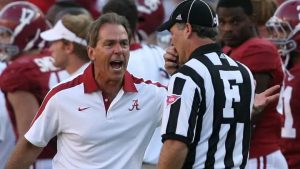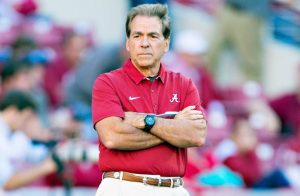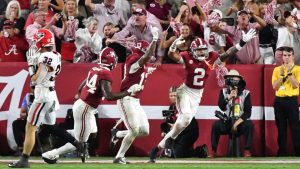
ESPN analysts—including Bill Barnwell—have spotlighted Arizona as one of the most likely teams to improve defensively in 2025. Barnwell’s assessment centers on two core factors:
- Strategic investments in the trenches, both through free agency and the draft, to fix a defense that struggled with pressure generation and run-stuffing in 2024.
- Continuity in coaching and a coherent scheme under Dean Pees’s former defensive coordinator Nick Rallis, promoting quicker adaptation and development.
Barnwell noted Arizona’s front-seven overhaul:
“new big bodies up front in Justin Jones, Bilal Nichols and first‑round pick Darius Robinson… all of whom should help a team that allowed 2.9 yards before first contact”—the 4th‑highest in the league.
He added that while the Cardinals still need an edge rusher or two, they’re not relying solely on veterans like Budda Baker or hoping for random breakthroughs.
This shows ESPN isn’t blindly optimistic—they’re weighing structural upgrades and realistic deficiencies. That foundation underpins the analyst’s projection: the defense should register measurable year-over-year improvement in key metrics.
2. Defensive Trenches: The Foundation of Turnaround
A. Interior Defensive Line (DT/3‑Tech)
Arizona prioritized beefing up the interior:
- Justin Jones – brought in via free agency; provides run-stuffing and inside pressure.
- Bilal Nichols – also added to fortify interior depth.
- Darius Robinson (1st‑round pick) – college standout with upside but needs to stay healthy after a 6-game rookie season marred by calf injury.
Why it matters: Arizona ranked near the bottom (C‑ grade) in interior pressure rate at just 18.1%, and lacked consistent disruption . With added talent inside, teams limit running lanes and force opponents to hold the ball longer—which boosts sack opportunities and reduces accuracy.
B. Edge-Rush Room
Edge pass rush remains a work in progress. The Cardinals added:
- Veteran **J.J. Watt**, who, despite not registering sacks early, has been a high-varying pressure contributor: 5 QB hits and 12 hurries through four games—second-most among interior linemen.
- They remain on the lookout for a 10-sack EDGE or rotational rusher. Discussions center around adding names like Christian Wilkins, Leonard Williams, DJ Reader, or Sheldon Rankins.
While they didn’t land a “blue-chip” edge, Watt provides leadership, versatility, and draws attention. With Watt, Robinson, Jones, Nichols, and Watt rotated along the front, Arizona’s front seven looks deeper and more disruptive.
3. Secondary: Youth, Upside & Veteran Support
Arizona’s secondary has a dual core:
- Budda Baker – coming off a career-high 164 tackles with a 77.8 PFF grade and a Pro Bowl selection.
- Jalen Thompson – veteran presence alongside Baker.
They also drafted Will Johnson (Michigan)—a second-round pick praised by Mel Kiper as a “Round 2 steal” thanks to his coverage skills and ball-hawk ability.
The secondary posted mid- to upper-tier numbers:
- Ranked 14th in passing yards allowed, 5th in passing TDs allowed.
- Showed flashes of dominance, e.g. shutting out the 49ers in the second half of a comeback in October 2024.
Melton and Williams’s emergence in 2024 also points to developing young talent. With more pressure upfront, these DBs will face fewer one-on-One situations. Coach Rallis can dial up coverage knowing the line can hold the pocket.
4. Coaching & Scheme: Consistency Driving Progress
- Defensive Coordinator Nick Rallis, in his second year, now has a full offseason to reinforce his scheme.
- DL Coach Winston DeLattiboudere III, formerly of Minnesota, joined on Feb 12, 2025—bringing proven techniques to improve interior rush performance.
Barnwell suggests scheme consistency matters here:
“individuals … improved from spring to spring … from schematic standpoint, technique, physical, psychological, health, all of it.
Improvement from “spring to spring” reveals an environment where fundamentals are being absorbed and amplified with continuity.
5. Statistical Context: 2024 Review & 2025 Projections
A. 2024 Review
- Interior pressure rate: 18.1%—27th in the NFL.
- Pass rush struggles: just 33 sacks, the lowest in the past decade.
- Run defense: ranked around 20th–22nd; allowed 2.9 yards before first contact.
- Pass defense: middle of the pack; 14th in yards allowed, 5th in passing TDs allowed .
B. 2025 Projections
Based on ESPN’s Bill Barnwell and others, we expect improvement in:
- Yards before contact – with quality DTs, likely moving inside the top 10–12.
- Pressure/sack generation – incremental edge contributions from Watt and depth from Robinson.
- Third‑down efficiency – better pressure + tighter coverage should reduce opponent convert rate.
- Turnovers – with more pressure, indirect spikes in picks and 3+ pass breaks.
Barnwell doesn’t forecast elite defense but sees wild-card contention. With a defense trending upward (bottom feeble in 2022–23, middling in 2024), 2025 may place Arizona around upper-tier 15–18, especially in rush/pass stalls.
6. What “Significant Improvement” Looks Like
Key Metrics to Watch
| Measure | 2024 | Projected 2025 |
|---|---|---|
| Yards before contact | ~2.9 | ≤2.5 (Top 8) |
| Pressure rate | 18.1% (27th) | ~22% (Top 10) |
| Sacks | 33 | 40–45 |
| Rush yards/game | ~132 | ~110 |
| Pass yards/game | ~228 | ~215 |
| Points allowed/game | ~26.6 | ~23–24 |
| Turnovers (INT + forced fumbles) | 9 picks | 12+ turnovers |
“Significant improvement” means statistically material—sub-24 PPG allowed and more disruptive play.
Team Impact
- Competitive games: they’d stay closer vs. top offenses (Rams, 49ers).
- Stronger in clutch: late-game inequality narrows.
- Morale boost: quicker three-and-outs energize the team and stadium.
- Wild-card contender: a respectable defense paired with a resurgent offense (Murray + Harrison Jr.) could push Arizona into playoff discussions.
7. Variables That Could Make or Break the Improvement
A. Health & Durability
- Robinson’s calf injury in 2024 cost ~11 games—repeat would stifle progress.
- Watt’s performance may dip if his body wears down. High leverage usage demands rotation.
B. Edge Play
- Watt jumps off the edge, but additional EDGE depth (via FA or midseason addition) would complete the front‑7 puzzle.
C. Secondary Development
- Johnson, Williams, Melton—rookies/sophomores need to tighten up consistency.
- Murphy‑Bunting’s penalty volume suggests discipline remains a concern.
D. Scheme & Accountability
- Rallis now has two seasons; buy-in can elevate execution.
- Situational fundamentals—third-and-short, red‑zone play—will matter. Defense must can hold teams without penalties.
8. Fanbase Perspective & Fan Sentiment
In r/Cardinals, discussions parallel analytical framing:
“On defense, we need a run stuffing IDL with pass rushing upside, a 10 sack EDGE rusher, a good rotational IDL, and a true CB1.” That lines up with what ESPN spotted in 2025’s additions.
Fans emphasize same chokehold: fix the interior, add an edge producer, and solidify a handful of DBs. It’s exactly the approach Arizona has taken—even though edge isn’t yet fully sealed.
9. The Quarterback Effects: Building on Offensive Turn
While analysis focuses on defense, it bolsters the offense:
- ESPN noted the connection between Murray’s presence and offensive tempo—Arizona jumped from 28th to 10th in EPA with Murray on the field.
- If defense holds more, it feeds off a positive feedback loop: less pressure on offense, fewer high-leverage situations, more strategic depth.
A balanced team (solid D and improved O-line) could turn mid-30s PPG losses into manageable low-20s games, creating far more win moments.
10. Final Verdict: Will the Defense Actually Improve?
✅ Yes, There’s a Legit Script
- Interior DL group—Jones, Nichols, Watt, Robinson—is deeper and more versatile.
- Secondary is young but developing, anchored by veterans.
- Coaching continuity means refined execution.
- Edge remains a question yet Watt provides coverage.
Risks
- Injuries to key acquisitions like Robinson.
- Lack of interior rotation could cause fatigue.
- Secondary discipline must tighten.
Watch Points
- Rookie OTAs/preseason: how interior depth performs.
- Early season offensive performance: if D shows in Week 1 and 2.
- Edge rotations: if Watt and Robinson both play 65–70% of snaps.
Prediction
If Barnwell’s thesis holds, expect:
- Statistically measurable improvement (5–10% better on all fronts).
- More competitive NFC West runs; wild-card talk midseason.
- Not elite defensively, but no longer a weakness. A difference-maker.
TL;DR
An ESPN analyst’s claim that Arizona’s defense “will improve significantly” isn’t hyperbole—it’s grounded in:
- Offseason strategy: adding depth and talent inside and along the edge.
- Youth development: secondary shows signs of becoming reliable.
- Scheme continuity: players and coaches aligned more than in 2024.
- Statistical optimism: metrics clearly point to room for leap.
The blueprint is in place. The Cardinals aren’t just expecting incremental change, but structured progress towards a defense that can support playoff contention—provided health, edge play, and situational execution all fall into place.
Key Takeaways
- Interior DL leveled up: expect better run defense and pocket collapse.
- Watt’s return offers versatile disruption.
- Secondary is growing up—watch Johnson, Williams, Melton.
- Continuity in coaching fosters faster learning.
- Projected metrics: fewer yards, better pressure, more stops.
- Risks: injuries, edge depth, DB discipline.
What to Watch in Training Camp & Preseason
- Robinson’s health: staying on the field matters.
- Watt’s usage: rotational edge vs. full-time interior frames.
- Third-down/red-zone defense: fundamental testing.
- DB discipline: penalties vs. explosive coverage.
Wrap-Up
In 2025, under analyst scrutiny, the Arizona Cardinals defense sits at an inflection point. A clear design, smart acquisitions, visible coaching consistency, and unquestionable upgrades—especially inside the trenches—have set the stage for a genuine leap.
This is more than offseason puffery: it’s a measurable, multi-dimensional rebuild. If cornerstones like Watt, Robinson, and Johnson deliver, Arizona could emerge with a defense that keeps games close, fosters momentum, and gives Murray & co. a fighting shot week after week.





